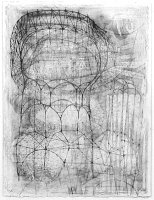
I managed to catch the Under Cover: Artist's Sketchbooks exhibition at the Fogg museum before it closed up shop on the 22nd of October. I was especially taken with the work of George Grosz and John Singer Sargeant. I have always been a fan of Singer Sargeant but Grosz was an artist I was not yet familiar with. His sketches of the Manhattan skyline rang clear and true to me. They seemed so effortlessly and expertly rendered. The deftness of his marks resonated within me. I thought to myself, "I want to do that. I CAN do that."

Seeing the artists' sketchbooks was a wonderful experience. It feels infinitely more intimate to be able to see these private journals like this, even though they are behind glass. You can witness the development of ideas, their thought processes much clearer and evident than in one of their masterful paintings. One can also identify more with these drawings. They are so small, the materials so familiar. You can feel closer to the artist via these miniature works in graphite, ink, or watercolor.

I loved seeing Singer Sargeants sketchbooks. For me, this was truly a privelage. I have always been awestruck by his work. His monumental paintings, his ethereal and celestial frescos in the MFA and Boston Public Library have always held me in rapt, silent awe. To see this master's work scaled down to such a small size evoked a giddiness in me. I felt like I had a VIP pass, like I was seeing something I wasn't supposed to. After years of thinking of him as some sort of demi-god of painting, I was thrilled to see the "behind the scenes" of all of his huge works. Technically speaking, he was beyond capable. His ability to render the human figure with such an economy of line and value is astonishing. He can create the most beautiful, languid, organic forms with what appears to be surgical precision. I am so pleased I was lucky enough to catch this exhibit before it was gone.





